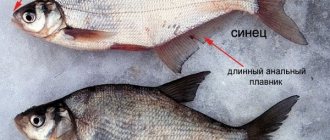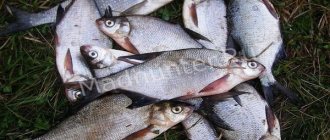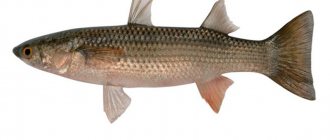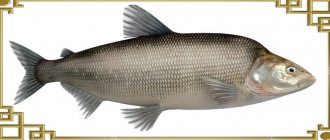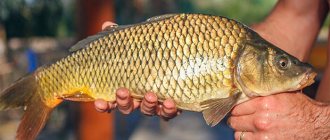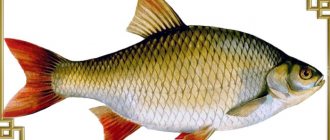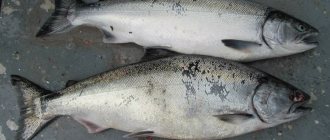White bream is a freshwater schooling fish from the Carp family, similar in appearance to white bream and bream. This is a separate genus with only one species, Blicca bjoerkna. Among fishermen, the only representative of the genus has many names: flatfish, weasel, lupirka, and the list of regional names is not limited to these names.
Where do you prefer to use fish?
- On the grill 19%, 210 votes
210 votes 19%210 votes - 19% of all votes
- For a couple 14%, 159 votes
159 votes 14%
159 votes - 14% of all votes
- In soups 14%, 157 votes
157 votes 14%
157 votes - 14% of all votes
- In cutlets 13%, 140 votes
140 votes 13%
140 votes - 13% of all votes
- In the smokehouse 11%, 119 votes
119 votes 11%
119 votes - 11% of all votes
- In batter 10%, 111 votes
111 votes 10%
111 votes - 10% of all votes
- I will cook according to your recipes 10%, 111 votes
111 votes 10%
111 votes - 10% of all votes
- In pies 9%, 99 votes
99 votes 9%
99 votes - 9% of all votes
- I don't eat fish 1%, 9 votes
9 votes 1%
9 votes - 1% of all votes
Total votes: 1115
16.09.2019
×
You or from your IP have already voted.
White bream and white bream are similar
Podleschik (Bream)
A bream is a young specimen of bream, the most famous of its kind to all fishermen. Carp family. Color depends on age and habitat. In young individuals, the scales are predominantly silver-gray in color, becoming golden with age. The white bream stays in small groups and in overgrown areas of the reservoir. He is often found to be quite smart and cautious. Underbreeders winter in deep places, partly in rivers and partly in the sea.
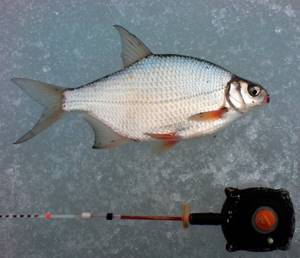
Gustera
White bream, unlike the bream, is less common in our reservoirs. It is the only representative of the genus Blicca. On the contrary, it lives in large flocks with individuals of similar size. It feeds well and actively on bait, driving away and outpacing even large bream. The silver bream is characterized by a high flock density. Scales are silver-gray.
These two species of fish are very similar to each other in body shape, scale color, and are found in the same bodies of water. Therefore, in order not to be mistaken about who is who, let's look at each of the fish in detail.
In the following video, the fisherman clearly shows and talks about the differences between silver bream and bream.
Taste characteristics
It tastes like bream or white bream. The meat is fattier than that of these fish, but there are also more bones. It is prized when dried for its fat. There is less meat itself, and this determines the peculiarities of drying. The small flatbread is not gutted or cut, which allows all the fat to be preserved inside, but is simply covered tightly with salt, placed under pressure for 3 days, and then hung out to dry. Thanks to the smaller amount of meat, silver bream prepared in this way differs for the better from white bream: it does not have time to acquire a characteristic and not entirely pleasant aroma.
Fish soup is prepared from this fish, as well as from other small bony fish. A good flatbread in marinade. You can deep fry it until the bones soften.
In terms of taste characteristics, small silver bream is not considered a delicacy, but it makes good traditional beer snacks. But the range of culinary uses of goiter is much wider. It is fried, steamed, baked over coals. For fish soup, they prefer to use other types; the zhoban in it is edible, but it cannot become a decoration for the dish.
Keep a close eye on your catch! Bream and bream up to 25-28 cm in length (depending on the specific region) are prohibited from catching, and the Fishing Supervision Authority seriously fines them for this. Practice shows: inspectors do not always behave honestly and sometimes play on fishermen’s poor knowledge of the species characteristics of the Cyprinidae family. The main difference between fish whose catch is limited and silver bream is the color of the fins. If they are bright, red and yellow, then do not give in to provocations: you have the right to catch up to 5 kg of such fish throughout Russia. But for small things with gray and black fins you will have to pay a fine.
White bream is especially common in the waters of the Black and Azov Seas, the Baltic and the Caspian Sea. But you can find this fish in almost any large body of water in Europe. It is not found only in Crimea, in Southern Europe and in Finland north of Lake Onega. In Russia, its habitat in the north reaches Arkhangelsk, and in the east it is probably limited to the Urals: in Siberia it has so far been found only in a tributary of the Tobol - the Iset River, which comes from the Ural Mountains.
The time to catch large silver bream is between May and June and the end of August. During the spring passage, it can peck at any time of the day, and in other months - from noon to sunset. There is no bite at night, this fish does not see well in the dark (therefore, at night there is a greater chance of catching underbreeders; the flat fish will not interfere). In spring, the fish are migratory, so there is no point in feeding them. In other months, she responds well to vegetable complementary foods: millet, peas and even buckwheat. But for greater effect, it is better to add protein to the mixture.
Differences in fin color and shape
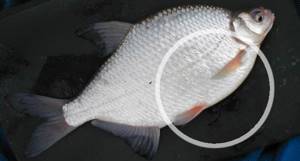
Gustera has paired lower and lateral fins that are red. Bream have gray
Gustera –
has 8 branched and 3 simple rays in the dorsal fin, 20-24 branched and 3 simple rays in the anal fin.
- The paired fins of the silver bream are reddish in color - this is the most obvious sign that this is a white bream and not a bream.
- Unpaired fins gray
Podleschik –
has a long anal fin originating in front of the dorsal fin.
- The light gray fins of the bream darken over time.
- About 30 rays in the anal fin.
Other Important Points
Bream and bream are considered one of the most common fish that many anglers “hunt”. The main feature is that this subspecies can be found in almost any river. Given the special taste of fish, it is served in many expensive restaurants, baked over coals, in the oven, steamed, etc. Dried bream is in particular demand. The fish meat is tender and lean, which cannot be said about the silver bream. This variety’s fillet is fattier and also richer, and the larger the individual, the more clearly this is felt.
It should be noted that, despite all of the above, perhaps not everyone will be able to immediately learn to distinguish one fish from another, but over time, with practice, everything will work out on its own. In addition to those points that have been presented, it must be said that it is important to pay attention not only to the appearance of the fish, but also to the characteristics of its behavior. White breams come for bait intermittently, which cannot be said about the silver bream. At the same time, you won’t find others at night.
Method of catching silver bream
Experienced fishermen advise adhering to the following rules if you are going to hunt silver bream:
- Use a fly rod and a light float.
- The thickness of the fishing line can be chosen at your own discretion.
- A sliding sinker is ideal, and hooks should be taken in the range from 14 to 18 numbers according to the international classification.
Please note that the length of the leash should not exceed 15 cm.
Many fishermen also advise using a feeder and donka. Before using it, it is necessary to examine the river bottom, namely, study:
- depth;
- speed of the current;
- drops and depressions.
To make the fishing process easier, you can use a weight with spikes. Once you locate the rock bottom, lower your rod, clip in, and start hunting.
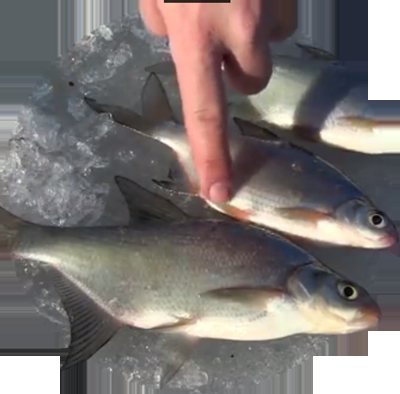
Depending on the time of year, there are certain fishing recommendations:
- In winter, it is recommended to catch silver bream using thin equipment. Considering that during this period of time the fish is less active, the size of the jig should not exceed the size of a match head.
- In the spring, you should look for the silver bream in river mouths, large backwaters and bays. Remember that after hibernation the fish begin to actively hunt for food. Try to sail as far as possible.
- The most active biting of the silver bream begins in June - by this time the fish have already finished spawning. You don’t have to swim far, because during this period of time the water warms up completely, so catching fish from the shore will not be a problem.
- If you go out for the silver bream in the fall, then you should sail further away. After all, the water begins to cool again, and the fish begin to look for warm places to winter. It is most effective to use a stationary bait.
We invite you to familiarize yourself with: White bream and white bream differences - RibaZdes
The white bream prefers clean reservoirs with a constant supply of fresh water. Does not like currents and is found less often in rivers. The most common feeding place is shallow water in thickets of algae or reeds, protected from attacks by predators, but accessible to fishermen. Young animals are careless and easily bite on simple baits.
Young animals can also form flocks with individuals of other species. He prefers the silver bream, because until sexual maturity it feeds only on zooplankton and remains harmless. This fish, similar in appearance to bream, confuses fishermen.
Difference between bream and white bream
But if you catch a white bream and a bream in one fishing trip, the differences will be obvious:
- Body color. The scales of adults are darker, with a yellowish tint. It is colored ocher in the center, silver underneath, and dark brown on top. The young are silvery from top to belly.
- Size. The ratio of sexually mature specimens to young ones (in length) is 1 to 3.
- Behavior. Young fish tend to gather in large schools and often stay in shallow water. They are less careful. Grown, experienced bream stay deep and prefer areas of the bottom where they can hide. They also walk in groups, but several fish at a time, rather than in large schools.
- Taste qualities. Undergrowth is less saturated. There are many bones in the body, which are difficult to separate. In mature fish, the meat is tender and easily removed from the bones, which become smaller in relation to the total body weight.
Another difference that will not be obvious when fishing is life tasks. In young animals, this is the food necessary to increase body length. As adults, goals change. Survival comes to the fore, fish often refuse the bait if they get scared. Spawning begins; for 1-2 weeks in the spring before reproduction, the grown bream develop a zhor. At this time, the fry eat actively, not so mindlessly.
External differences
At first glance, the differences between the silver bream and the white bream are not obvious, however, taking a closer look at these fish, the angler will quickly find several signs by which the species can be accurately determined. Ichthyologists easily distinguish these species by counting the number of rays in the fins and the number of scales located on the lateral line of the fish. An angler is unlikely to waste fishing time on such a detailed study, but rather will prefer simpler identification methods.
Important! If a fisherman cannot accurately determine which fish he caught on the hook, then first of all you should pay attention to the color of its ventral and pectoral fins. The fins of the silver bream have a reddish or orange tint.
We suggest you familiarize yourself with: Fishing rod for pike with live bait, installation
The pectoral and ventral fins of the bream are gray. The anal fin of the white bream is almost twice as long as that of the silver bream.
Those fishermen who have at least once caught a white bream have noticed that its body is abundantly covered with transparent mucus, which performs protective functions and protects the fish from blood-sucking water parasites. There is also mucus on the body of the silver bream, but it is much less. Compared to the white bream, the eyes of the silver bream are larger and have a yellowish tint.
One of the main differences is the difference in the structure of the oral apparatus. The white bream feeds primarily from the bottom of the reservoir, so in the process of evolution its mouth has acquired a complex structure that can extend into a tube while feeding. The silver bream prefers to feed in the middle layers of water, so its mouthparts are not equipped with long lips capable of stretching.
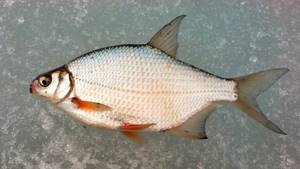
Red fins are the main distinguishing feature of the silver bream.
Ide and chub
Since the bream is a juvenile bream, fat in its body is not accumulated, but is spent on growth, so it has a flat body shape and does not have good taste. White bream is a sexually mature fish, so its body shape is more rounded, and its meat is much fattier and much more highly valued in cooking. To summarize, we can say that the silver bream differs from the white bream in the following external characteristics:
- fin color;
- eye size;
- the amount of mucus on the scales;
- the structure of the oral apparatus;
- body shape.
The external differences between silver bream and bream are more obvious, so it is almost impossible to confuse these fish. If the maximum weight of a silver bream rarely exceeds 800 grams, then a bream is considered to be an individual that has surpassed the kilogram mark. These types of fish also differ in the color of their scales. Bream has a bronze color, while silver bream is characterized by silvery scales. In addition, bream are distinguished from silver bream by the structure of their mouthparts, the color of their fins and their body shape.
When does a bream become a bream?
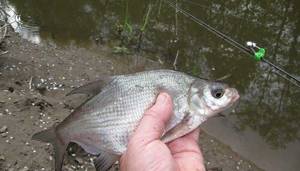
Sexual maturity of the species is from 3 to 4 years. By this age, the white bream gains a mass of 500 g or more, and a length of 35 cm. The color of the scales changes to darker. The transition to a new state is marked by spawning: at the end of spring, matured individuals begin to more actively find food, look for a partner, milt swells, and spawning begins.
